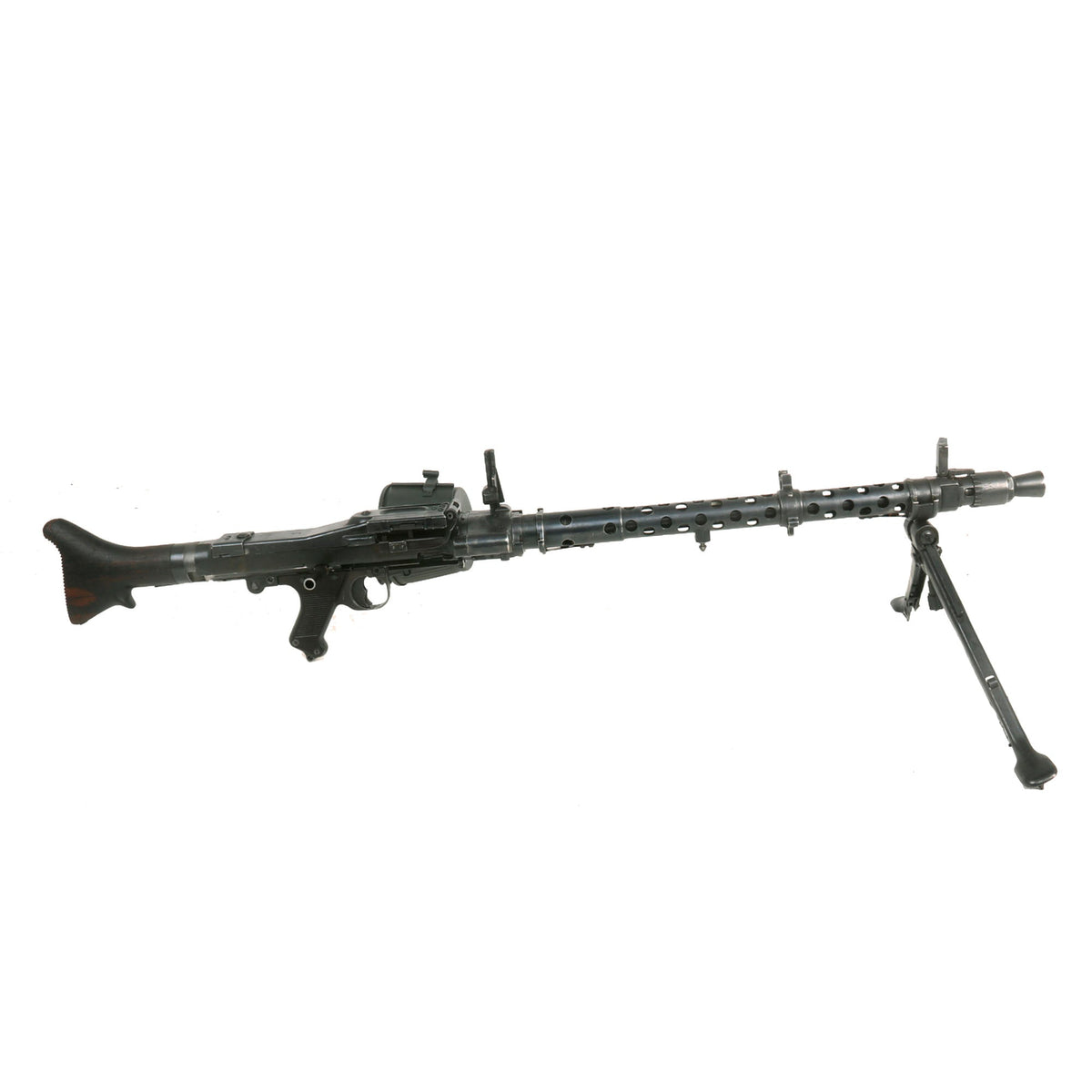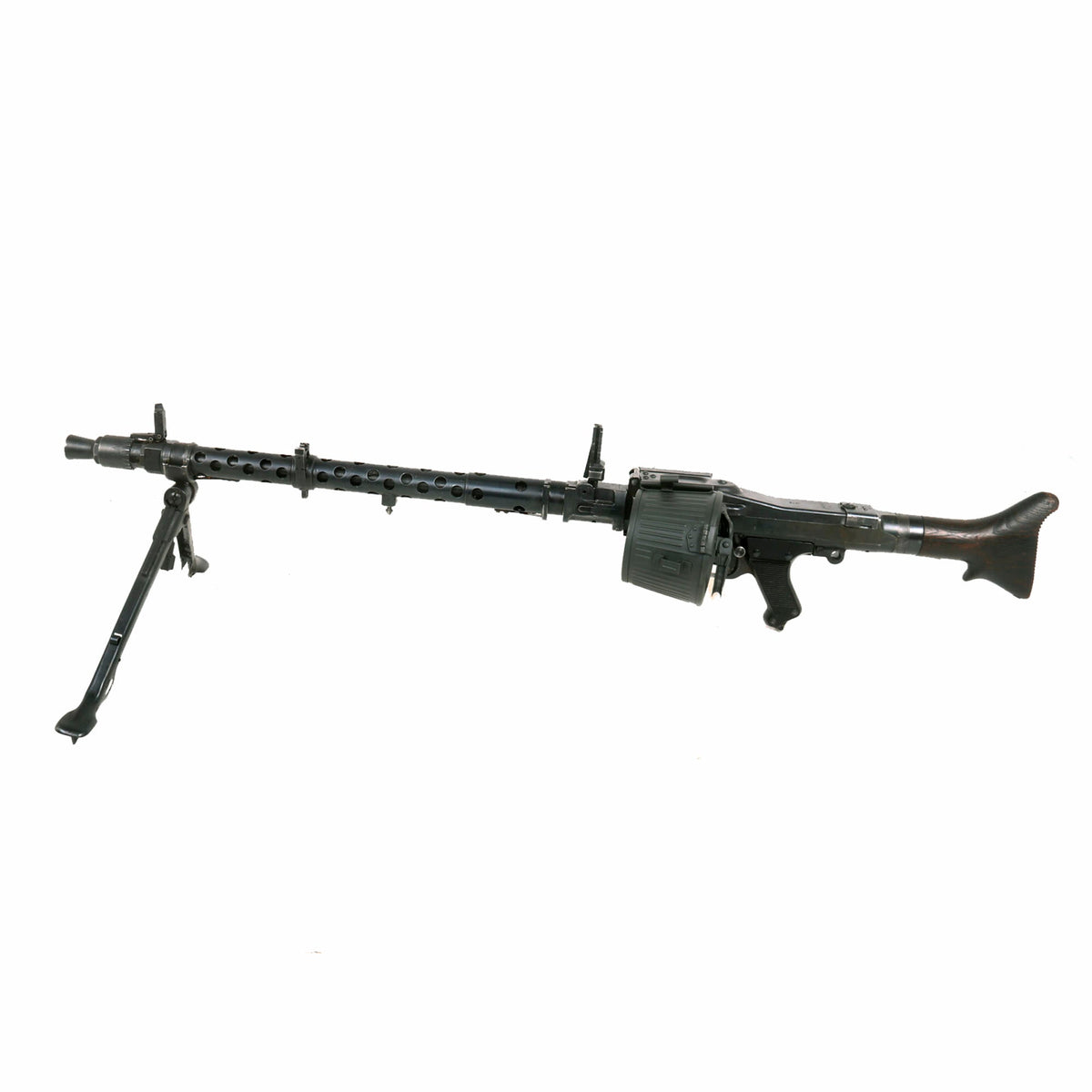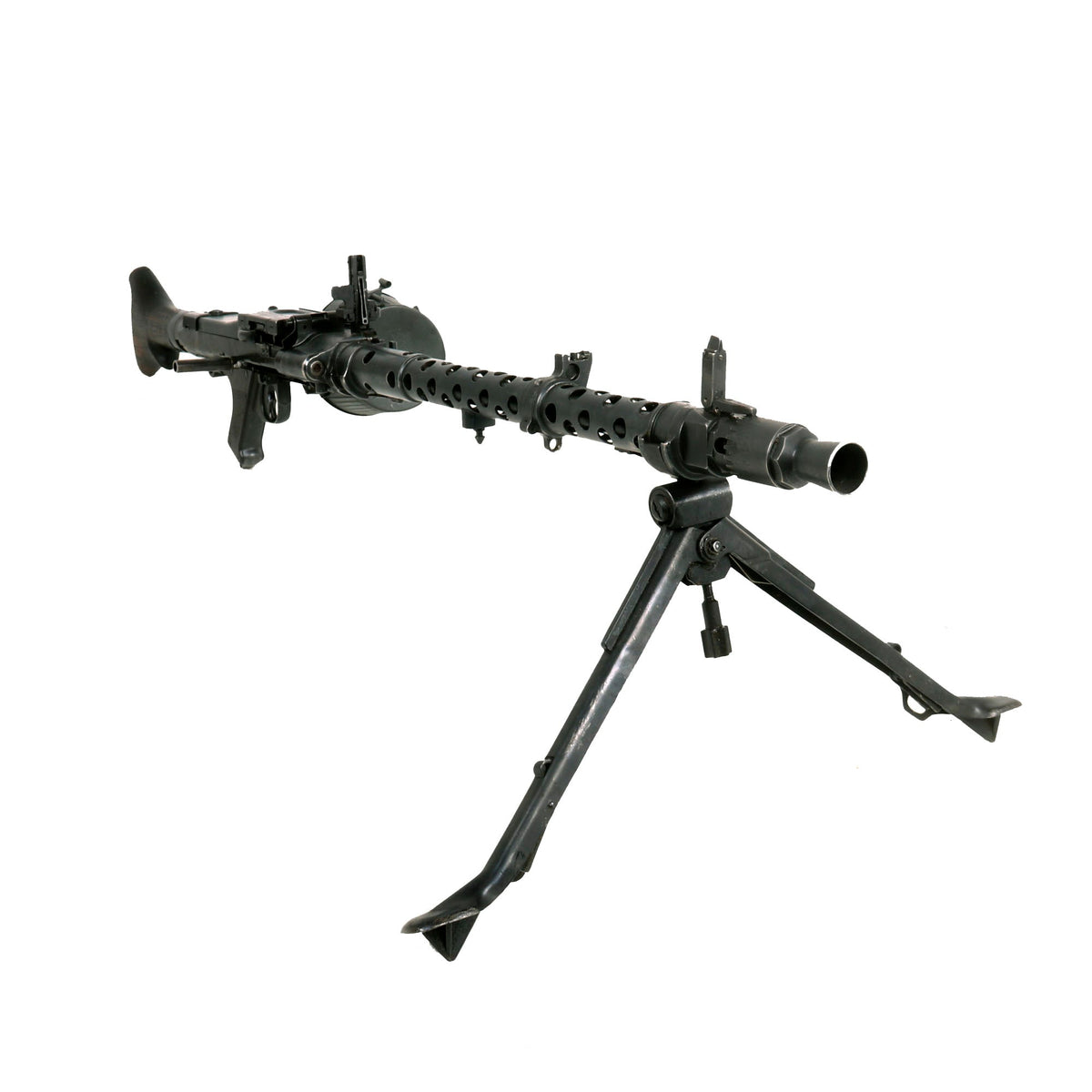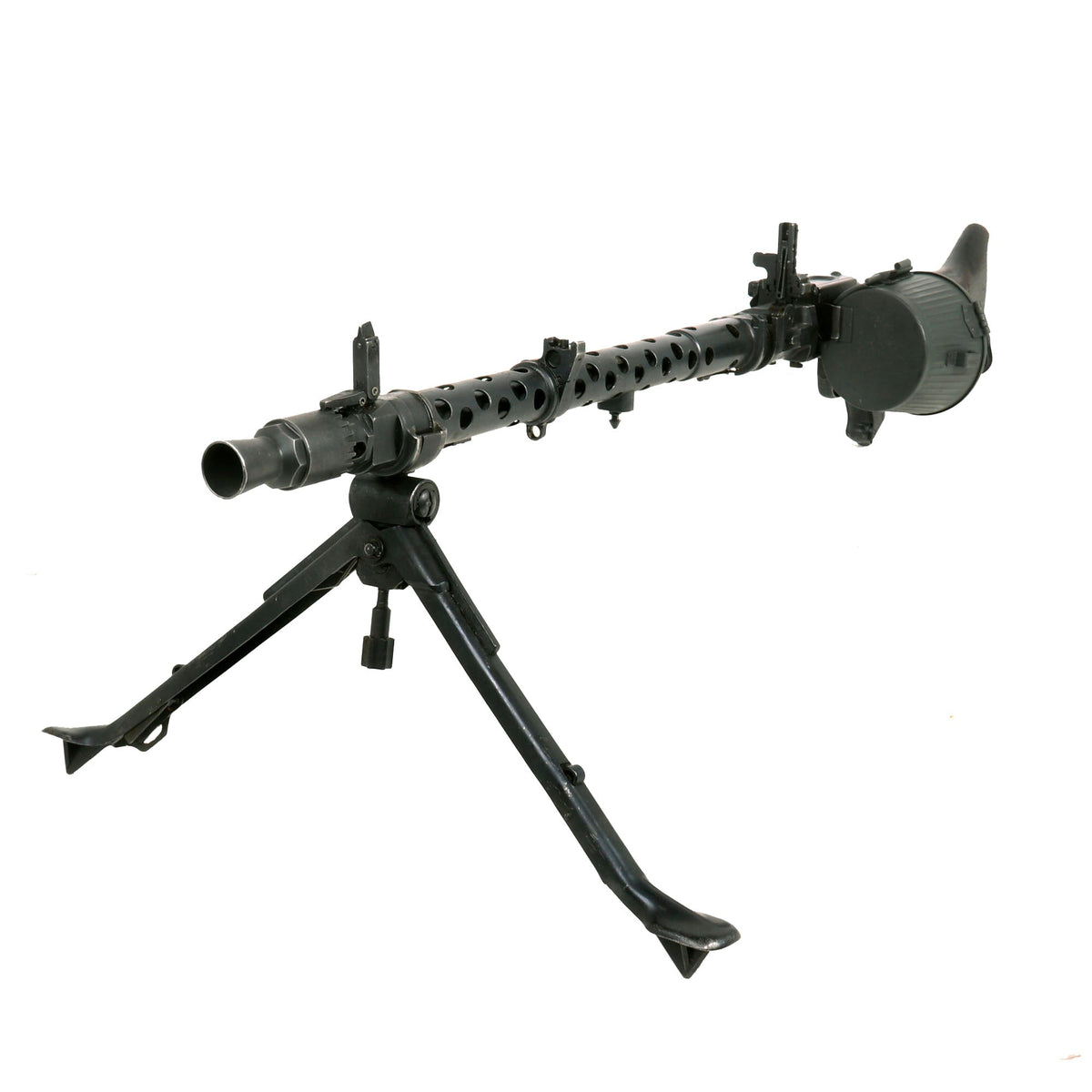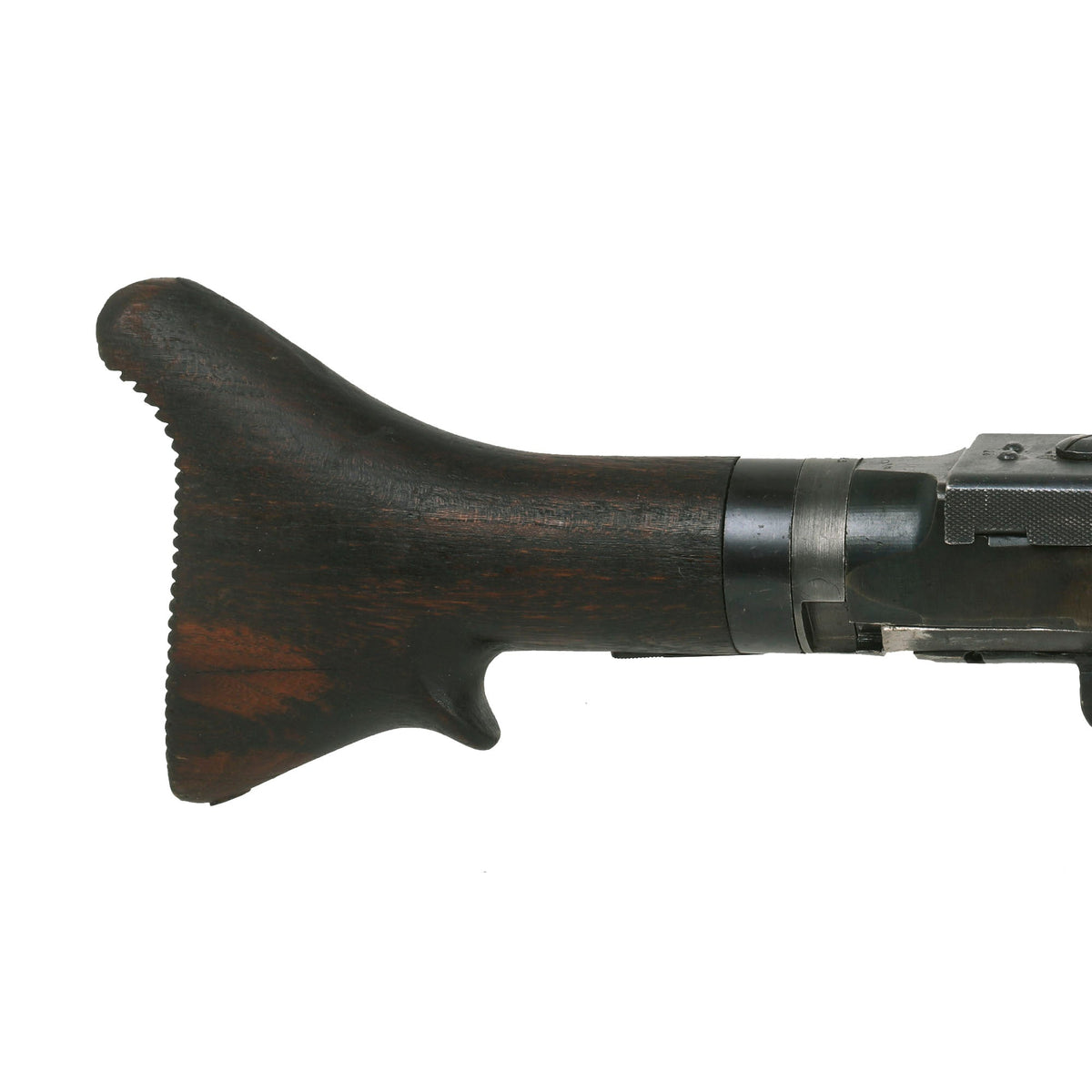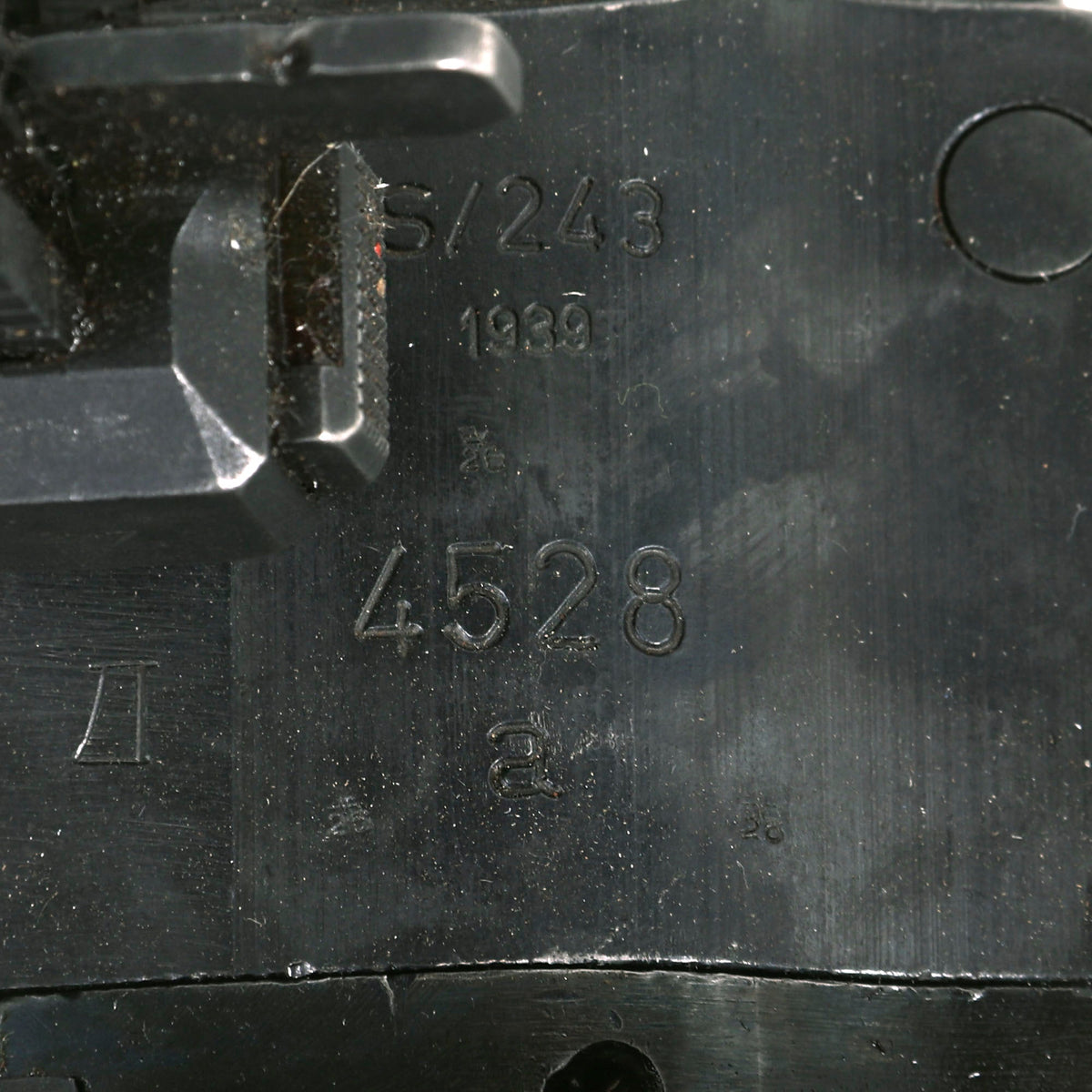Original German Early WWII MG 34 Display Machine Gun by Mauser Werke with Belt Carrier, Belt & Starter Tab – dated 1939 Original Items
$ 4.495,00 $ 1.123,75
Original Item: Only One available. Constructed from a legally demilitarized (de-milled) parts set, this is a wonderful and rare German WWII MG 34 Display Machine Gun. It is built from all original parts on an original BATF compliant non-firing display receiver, making this a 100% legal display machine gun. This receiver was created by using portions of the original torch cut receiver, including the barrel bushing, combined with some new made steel portions. It has properly had a 25% section of the total length completely replaced entirely with solid steel bar stock. Meaning a 1/4 length section of the display receiver is solid steel, making this legal to own without a license of any kind. We have also included a basket belt drum carrier painted with our Panzergrau (Armor Gray) paint to complete the look, which contains an original belt and starter tab.
This is one of our original early WWII issue MG34 display machine guns, which is coded along with multiple German wartime markings and has multiple Waffenamt markings. The barrel jacket is marked with the maker code S/243, a pre-WWII Zahlencode (Number Code) listing. This indicates manufacture by the legendary Mauser-Werke AG in Berlin-Borsigwalde. Below this is a 1939 date, above original serial number 4528 / a. There are also three Eagle / 26 Waffenamt Proofs, the correct inspector for this factory location. There really are some great markings on this very fine example of the most prolific German issued Light Machine gun of WWII, with lots of potential for research.
The top cover is marked with number code 799, another pre-WWII Zahlencode (Number Code), which we actually have not been able to identify. The top cover is marked with MATCHING serial number 4528 / a, so this is the original top cover issued with the barrel jacket! The top cover is also Waffenamt marked with Eagle / WaA497 and Eagle / 26, indicating it was most likely made by a subcontractor and then inspected again at Mauser. Inspector 497 was based in Döbeln, Sachsen, which makes this an excellent opportunity for further research. The feed tray is marked with arz for subcontractor Deutsche Kühl- und Kraftmaschinen GmbH, who supplied many makers with stamped steel parts.
The bipod included is of the early war design, with the central height adjustment knob, and is in very good condition. It is maker marked with what looks to read swnz 39 (or maybe swhz) on the central hub, surrounded by two Waffenamt Eagle / WaA710 inspection stamps. This is not a marking that we recognize, and we were not able to associate any maker with the inspection code either. We think possibly it is an early code from Steyr, who used letter codes “bnz” and “swj” later in the war. The front and rear sight still flip up and function correctly, and the bipod folds away and locks in correctly. The rear wooden butt stock has a great lightly worn worn look to it and a lovely dark stained color from decades of storage. There are additional serial numbers and German proof marks on many other parts of the display gun, particularly on the rear of the receiver and on the fittings for the butt stock.
A fine early production display MG 34 LMG, complete with an original repainted belt drum, belt, and starter tab. One the very last we have to offer, just perfect for your collection. Ready to research and display!
Please note that there may be various post-war markings on this display gun, in addition to the German WW2 markings. Many of these were acquired out of Israel, so many parts may have markings in Hebrew and “Star of David” proofs.
The Maschinengewehr 34, or MG 34, is a German recoil-operated air-cooled machine gun, first tested in 1929, introduced in 1934, and issued to units in 1936. It accepts the 7.92×57mm Mauser cartridge, and is generally considered the world’s first general-purpose machine gun.
The versatile MG 34 was arguably the most advanced machine gun in the world at the time of its deployment. Its combination of exceptional mobility – being light enough to be carried by one man – and high rate of fire (of up to 900 rounds per minute) was unmatched. It entered service in great numbers following AH’s repudiation of the Versailles Treaty in 1936, and was first combat tested by German troops aiding Franco’s Nationalists in the Spanish Civil War. Nonetheless, the design proved too complex for mass production, and was supplemented by the cheaper and simpler MG 42, though both remained in service and production until the end of the war.
History
The MG 34 was based on a 1930 Rheinmetall design, the MG 30. The Swiss and Austrian militaries had both licensed and produced the MG 30 from Rheinmetall shortly after patent. The MG 30 design was adapted and modified by Heinrich Vollmer of Mauser Industries. Vollmer modified the feed mechanism to accept either drum magazines or belt ammunition. He also increased the rate of fire. The MG 34’s double crescent trigger dictated either semiautomatic or fully automatic firing modes.
In the field, the weapon could operate in offensive or defensive applications. The offensive model, with a mobile soldier, used a drum magazine that could hold either 50 or 75 rounds of ammunition. In a stationary defensive role, the gun was mounted on a bipod or tripod and fed by an ammunition belt. Belts were carried in boxes of five. Each belt contained 50 rounds. Belt lengths could be linked for sustained fire. During sustained fire, barrels would have to be changed at intervals due to the heat generated by the rapid rate of fire. If the barrels were not changed properly, the weapon would misfire. Changing barrels was a rapid process for the trained operator and involved disengaging a latch and swinging the receiver to the right for the insertion of a new barrel. Accordingly, stationary defensive positions required more than one operator.
The MG 34 was the mainstay of German Army support weapons from the time of its first issue in 1935 until 1942, when it was supplanted by the next generation Maschinengewehr 42 or MG 42. Although the 34 was very reliable and dominant on the battlefield, its dissemination throughout the German forces was hampered due to its precision engineering, which resulted in high production costs and a relatively slower rate of production. For its successor, the MG 42, the Germans instead used mass production techniques similar to those that created the MP 40 submachine gun. However, the Germans nevertheless continued widespread production of MG 34s until the end of the war.
The MG 34 was used as the primary infantry machine gun during the 1930s, and remained as the primary armored vehicle defensive weapon. It was to be replaced in infantry service by the related MG 42, but there were never enough quantities of the new design to go around, and MG 34s soldiered on in all roles until the end of World War II. The MG 34 was intended to replace the MG 13 and other older machine guns, but these were still being used in World War II as demand was never met.
It was designed primarily by Heinrich Vollmer from the Mauser Werke, based on the recently introduced Rheinmetall-designed Solothurn 1930 (MG 30) that was starting to enter service in Switzerland. Changes to the operating mechanism improved the rate of fire to between 800 and 900 rpm.
The new gun was accepted for service almost immediately and was generally liked by the troops, and it was used to great effect by German soldiers assisting Nationalist Spain in the Spanish Civil War. At the time it was introduced, it had a number of advanced features and the general-purpose machine gun concept that it aspired to was an influential one. However, the MG 34 was also expensive, both in terms of construction and the raw materials needed (49 kg (108.0 lb) of steel),[citation needed] and its manufacture was too time-consuming to be built in the numbers required for the ever-expanding German armed forces. It was the standard machine gun of the Kriegsmarine (German navy).
Fast Shipping with Professional Packaging
Thanks to our longstanding association with UPS FedEx DHL, and other major international carriers, we are able to provide a range of shipping options. Our warehouse staff is expertly trained and will wrap your products according to our exact and precise specifications. Prior to shipping, your goods will be thoroughly examined and securely secured. We ship to thousands clients each day across multiple countries. This shows how we're dedicated to be the largest retailer on the internet. Warehouses and distribution centres can be located throughout Europe as well as the USA.
Note: Orders with more than one item will be assigned a processing date depending on the item.
Before shipping before shipping, we'll conduct a thorough inspection of the items you have ordered. Today, the majority of orders will be delivered within 48 hours. The delivery time will be between 3-7 days.
Returns
The stock is dynamic and we cannot completely manage it because multiple stakeholders are involved, including our factory and warehouse. So the actual stock may alter at any time. It's possible that you may not receive your order once the order has been made.
Our policy is valid for a period of 30 days. If you don't receive the product within 30 days, we are not able to issue a refund or an exchange.
You can only return an item if it is unused and in the same state as the day you received it. You must have the item in its original packaging.
Related products
Uncategorized
Uncategorized
Uncategorized
Uncategorized
Uncategorized
Armoured Fighting Vehicles of the World: AFVs of World War One (Hardcover Book) New Made Items
Uncategorized
Uncategorized
Australian WWII Owen MK1 Machine Carbine SMG Custom Fabricated Replica with Sling Original Items
Uncategorized
Uncategorized
Uncategorized
Uncategorized
Uncategorized
Uncategorized
Armored Burgonet Helmet & Polearm from Scottish Castle Leith Hall Circa 1700 Original Items
Uncategorized
Uncategorized
Angolan Rebel 1970s era 60mm Inert Display Mortar from Angolan Civil War Original Items
Uncategorized
